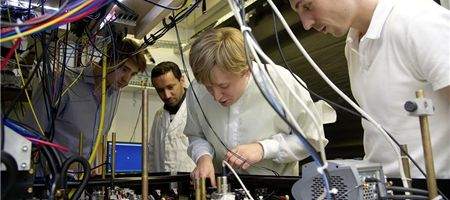Forget clumsy nuclear fission: researchers have now split an atom into two halves, pulled them apart and put them back together again.

The University of Bonn team used quantum mechanics, which allow objects to exist in several states simultaneously, to perform the feat.
Their experiment involved keeping a single atom simultaneously in two places that were more than a hundredth of a millimeter apart – an immense distance for an atom.
The scientists say they want to build quantum mechanics bridges by letting the atom touch adjacent atoms while it’s being pulled apart, so that it works like a bridge span between two pillars.
The quantum effects can only take place at very low temperatures. A cesium atom is cooled using lasers to a temperature of a tenth of a million above absolute zero, and then held with another laser.
Atoms have a spin that can go in two directions; and, depending on the direction, they can be moved to the right or the left by the laser. And because the atom’s spin can be in both directions simultaneously, it can be moved to the right and left at the same time, making it split.
“The atom has kind of a split personality, half of it is to the right, and half to the left, and yet, it is still whole,” says the university’s Andreas Steffen.
The Bonn scientists are hoping to use the technique to simulate complex quantum systems.
“For us, an atom is a well-controlled and oiled cog,” says team leader Dr Andrea Alberti. “You can build a calculator with remarkable performance using these cogs, but in order for it to work, they have to engage.”
Because the two halves are put back together again, they can make contact with adjacent atoms to their left and right and then share that contact. This allows a small network of atoms to form – a network that could potentially be used to simulate and control real systems.






